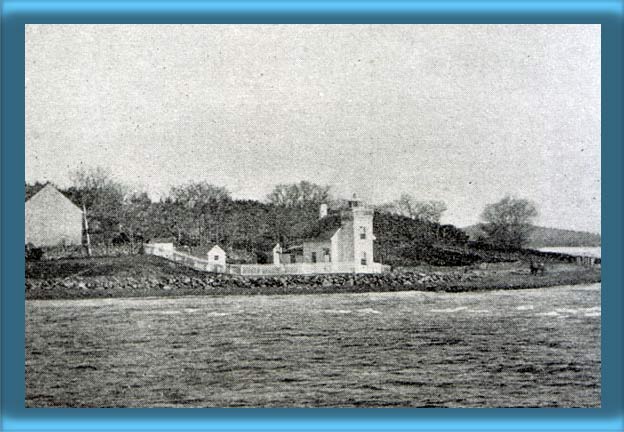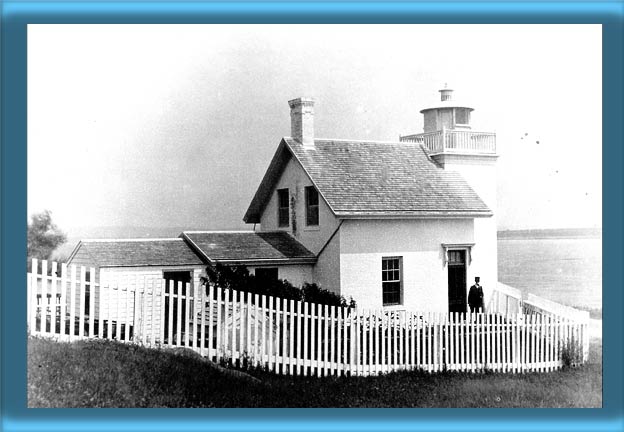It was difficult to keep the lamp lighted in windy weather, because it had no protection. In strong winds the light would go out as many as six times a night. The keeper would have to relight it immediately. An article in the October 15, 1894 edition of The Fall River Daily Herald described how it was done.
"It was done in this manner: The keeper had a large, heavy cloak, which he carried with him as he climbed to the top of the spar, and, unfolding it, he enveloped the lantern and his own person also; he then fastened the cloak at the top and bottom, thus shutting out the wind , which left him free to use matches in relighting the lamp. This done, he unfastened the cloak, folded it up and descended to the ground again. He then went to his residence, which was a short distance back from the beach, watched the light until it went out again, when he would have to repeat the process."
In 1853 a petition was sent to the Lighthouse Board requesting that a government lighthouse be built at Bristol Ferry to replaced the one run by The Old Colony Steamboat Company. One of its signers, William Brown, Master of the Steamer Bay State, felt so strong about the need for a government light that he wrote a letter to the Lighthouse Board. In it he stated, "There is probably no locality in the country, certainly none within my knowledge, where a lighthouse is so much needed." Within months of receiving his letter, Congress appropriated $1,500 to build the lighthouse.
Bristol Ferry lighthouse, a square brick tower and attached keeper's dwelling, was completed in 1855 and was first lighted on October 4. It was built fifty-three feet northwest of the old light. George Pearse was Bristol Ferry's first keeper. He was the keeper for less than a year.
On October 6, 1894 Captain W. S. Schley the third Lighthouse District inspector went to Bristol Ferry Lighthouse on an inspection tour. After he inspected the light, he told the lighthouse's keeper, Edward Sherman, the light would closed because it wasn't needed. Sherman was told he would be transferred to Gull Rock Lighthouse.
The Lighthouse Board may have felt that Bristol Ferry wasn't needed because of its close proximity to Mussel bed Shoal Lighthouse and Hog Island Shoal Lightship. Mussel bed Shoal Light was only a half mile southeast of the light and Hog Island Shoal Lightship was a mile southwest of it.
The Old Colony Steamboat Company and other shipping companies in Narragansett Bay complained about the closure. The Old Colony Steamboat Company felt that a light at Bristol Ferry was so important to their company that they would buy the lighthouse and run the light if it was closed. In the November 8, 1894 edition of the Fall River Globe, a Fall River Line Captain stated in simple terms why it was so important to them.
"It often happens that coalers and heavily laden schooners are bucking the tide
at this point when the boats are on their
way up the river. On a foggy morning
their position may be extremely dangerous and a light on the shore may save
hundreds of lives not to speak of the
property."
The Lighthouse Board changed its mind two months later and kept the lighthouse open. Keeper Sherman remained at the lighthouse.
A. H. Barney transported the Providence Journal newspapers from Providence to Portsmouth every Sunday. He would ride a horse from Providence to Bristol Ferry. He would switch to a boat and row across to Portsmouth and hand them off to someone to take them to Newport. On May 8, 1898 as he was returning from Portsmouth, the boat was swamped and overturned.
Keeper Sherman saw the boat overturn. He called for help and ran to the beach. Sherman and a few men launched a boat and rowed to Barney. They couldn't take him into the boat because of the weather and his heavy waterproof clothing. Barney was tied to the back of Sherman's boat and was rowed back to the lighthouse. He recovered and went home the next day.
The government never installed a fog signal at Bristol Ferry Lighthouse. To help there ships get past Bristol Ferry in foggy weather, the Old Colony steam boat company paid the lighthouse keepers to blow a horn when their ships passed.
An inspection in 1916 found the wooden lantern to be in such bad condition that it had to be replaced. An iron lantern, from the discontinued Rondout light in New York, replaced it.
Bristol Ferry Light was discontinued in 1927 when construction started on the Mount Hope Bridge. The lantern and Fresnel lens were removed when the lighthouse closed. A light on a skeleton tower replaced it. Mount Hope Bridge was completed in 1929. The skeleton tower was removed in 1934.
In 1929, the Bureau of Lighthouses held a public auction to sell Bristol Ferry. The bids were opened on April 4. Anna Santull placed the highest bid, $2,050. This was well below the property's estimated value of $3,900. The Bureau of Lighthouses accepted her bid because the property had been heavily advertised and it was doubtful that readvertising it would have brought a higher bid.
After years of disrepair, new owners renovated the lighthouse in the early 1990's. During the renovation a new mahogany lantern was placed on the tower. In May 1999, Bristol Ferry was put up for sale, with a $469,000 asking price.
In August 2022 Bristol Ferry put up for sale again. It was listed at $750,000 by Mott & Chace Sotheby's International Realty. Kim Holland, the agent who represented the seller, said "The preservation of the lighthouse tower makes this one of the most unique homes in Rhode Island," It was sold in September 2022 for $805,000.
| Bristol Ferry Lighthouse in 1900 |
|---|
 |
| Courtesy of N.L. Stebbins |
See more of Bristol Ferry Lighthouse in Rhode Island Lighthouses: A Pictorial History by R Holmes.
